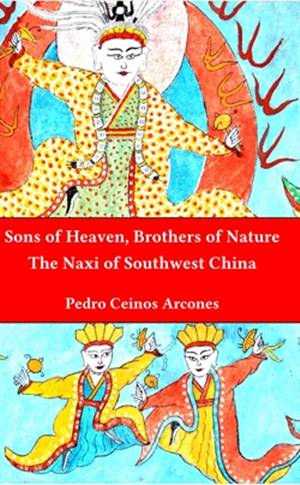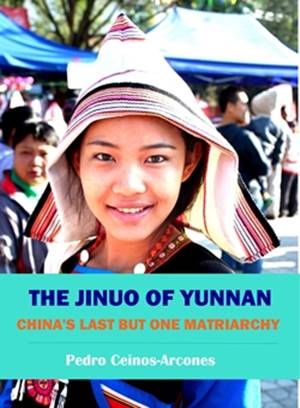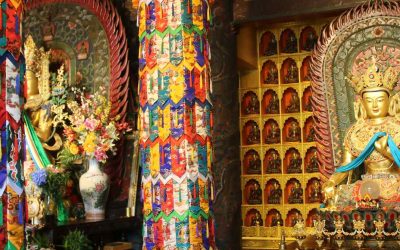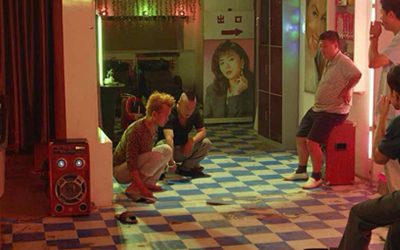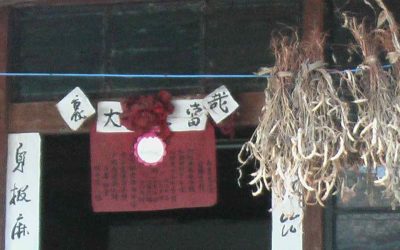In the fourth chapter of India in the Chinese Imagination: Myth, Religion, and Thought (edited by John Kieschnick and Meir Shahar, University of Pennsylvania Press, 2014), Nobuyoshi Yamabe contributes an article (Indian Myth Transformed in a Chinese Apocryphal Text: Two Stories on the Buddha’s Hidden Organ) about a rarely touched matter: The sexual organ of Sakyamuni Buddha.
This chapter is a discussion of two fairly peculiar stories found in the “Sūtra on the ocean-like samādhi of the visualization of the Buddha”, which was allegedly translated to Chinese by Buddhabhadra in the fifth century.
In the standard hagiography of Buddhism, the Buddha’s male organ is said to have been concealed and invisible from the outside. This is not the type of topic that receives major attention in Buddhist scriptures. The Ocean Sūtra has a chapter that is exclusively devoted to this topic, including some strange stories, one of which the author translates:
“A large ring of prostitutes came to Śrāvastī from Mathurā and were doing many evils. Three sons of a rich merchant Rulüda frequented their place and wasted their father’s money. Worrying about this, Rulüda went to King Prasenajit and asked him to execute all the prostitutes. However, the King kept Buddhist vows and did not want to kill people. Therefore, the King went to the Buddha and asked him to admonish the prostitutes.
The Buddha informed Sudatta that he would teach the prostitutes at a debate hall (shichang) in seven days. When the day came, the King beat a golden drum and made all debaters in the country come to the debate hall. All members of the sangha and the prostitutes were also summoned.”
“Then each of the great disciples of the Buddha created his own vehicle, such as a cave, nāgas, and a jewel tree, and, performing miracles in concentration, flew to the debate hall. Finally, the Blessed One led Ānanda and, walking in space, came to the debate hall. The Buddha took a seat and briefly taught about suffering, emptiness, impermanence, and the perfections (pāramitā) to the assembly, but the women did not accept [his teaching].
Among the group of women, a prostitute, Lovable by name, said to the women: “The ascetic Gautama has no desire by nature, and people say that he is impotent. That is why he denounces desire in public. If his bodily parts are complete, he should clearly show us that he has this mark like the Jains did. [If he does so], we will become his disciples. If he does not have this mark, he denounces impurity in vain. This person without an organ has no desire by nature; why would he not preach that desire is impure?”
[The prostitute] having thus spoken, the Tathāgata magically created an elephant. A white lotus emerged between the legs of the elephant and touched the ground. Having seen this, the women burst into laughter. They said to one another: “The ascetic is good at conjuration.” The Buddha also magically created an image of a horse king, who extended his retracted organ. It hung like a beryl cylinder and reached his knees. Having seen it, the women said even more that it was conjuration. After that, the Buddha dismissed the entire audience and confronted the prostitutes by himself. The women laughed loudly and said: “Ascetic, do you have the bodily part or not?” The Buddha said: “I have a complete male body. I am a sound man.”
At that time, the Blessed One opened his undergarment (nivāsana). [The women] saw the Buddha’s body, [which was] entirely flat. Then, [his organ] gradually emerged like that of a horse king. When it first appeared, it was like the bodily organ of an eight-year-old boy, and it gradually grew into the shape of that of an adolescent. Seeing this, all the women rejoiced. Then the hidden organ gradually grew [and became] like a cylindrical banner of lotus flowers. In each layer there were ten billion lotuses; each lotus had ten billion jewel colors; each color had ten billion emanation Buddhas; and each emanation Buddha was served by ten billion bodhisattvas and a boundless assembly.
Then the emanation Buddhas unanimously criticized the faults of the bad desires of the women. Upon hearing this, the prostitutes were overcome by shame and submitted to the Buddha’s teaching. Listening to the Buddha’s sermon, they reached spiritual attainments of various degrees.
More posts on Chinese culture
The Filial Peasant Girl – A Buddhist Miracle Tale
The Filial Peasant Girl - A Buddhist Miracle Tale With the arrival of Buddhism in China, in addition to translating the main canonical scriptures, other more popular religious literature began to emerge, which by means of some tales narrating either the benefits of...
Shock Wave 2- An entertaining action movie
Shock Wave 2- An entertaining action movie In short: A nice movie, with an original script, plenty of surprises, the right dose of love, and a slightly exaggerated dose of violence, but nothing excessive for what is fashionable nowadays. The year 2020 seems to have...
Hong Ying- An Art of Love without art and without love
Hong Ying- An Art of Love without art and without love In Brief: A scandalous novel that fails to shock, and an art of love that is conspicuous by its absence. Already from the beginning, we know that this is a love story without a future because the novel begins with...
Black Coal, Thin Ice, by Diao Yinan
Black Coal, Thin Ice, by Diao Yinan In short: a film narrated in a gray and sometimes sordid atmosphere, in a dark winter, of climate and spirit, which presents a mystery in which the viewer is gradually seduced. In an eminently mining region, human limbs begin to...
Xian, the ancient imperial capital
Xian, the ancient imperial capital In short: The ancient city inside the city wall retains a fascinating atmosphere. Its great monuments on the outskirts, such as the Terracotta Warriors, are among China's favorite attractions. Xian is undoubtedly one of the most...
Xin Ran – Sky Burial: An Epic Love Story of Tibet
Xin Ran - Sky Burial: An Epic Love Story of Tibet In Brief: A work full of exoticism that describes some interesting customs of the Tibetan nomads, but fails to convey emotions to the reader. Sky Burial: An Epic Love Story of Tibet is a novel set in the late 1950s. A...
More posts on China ethnic groups
Zhuang Folk Tales from Wuming
Zhuang Folk Tales from Wuming This book is a good sample of the folk literature of the Zhuang people living around Wuming County. Though formally separated in six chapters under the epigraphs of Traditional virtues, Bravery and Diligence, Cleverness and Creativity,...
Researches on the Mo culture of the Zhuang
Researches on the Mo culture of the Zhuang (壮族墨文化研究 Zhuang zu mo wenhua yanjiu). Huang Guiqiu。 Nationalities Press. Beijing. 2006. 321 pp Mo culture of the Zhuang refers to the Mo beliefs of the Zhuang and the Buyi nationalities; as their culture share a high...
Deciphering the culture of the fertility cults
Deciphering the culture of the fertility cults (生殖崇拜的文化解读 Shengzhi chongbai de wenhua jiedu). Liao Mingjun. Guangxi Peoples Press. Nanning, 2006 This book is a study of the fertility cults among the Chinese nationalities. Introducing the reader the different...
Pregnancy and Birth ceremonies among the Sha branch of the Zhuang
Pregnancy and Birth ceremonies among the Sha branch of the Zhuang The Sha are one of the branches of the Zhuang. They live in Yunnan province. The birth of a new child among them is surrounded by rituals that present significant differences from those of other...
Some dances of the Zhuang people
Some dances of the Zhuang people The Zhuang have a number of dances. Originating from different periods of their history, it is thought that the older ones have a ritual origin, imitating the movements of their shamans during their religious ceremonies. In general...
Festivals of the Zhuang Nationality
Festivals of the Zhuang Nationality New Year The most important festival of the Zhuang year. Their celebration is similar to that of the local Chinese, although with some special characteristics. The children play their traditional games. In Wenshan County horse...


